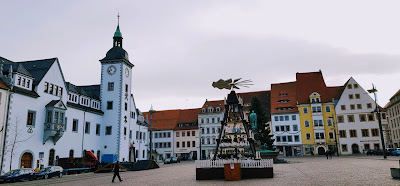we have divided our trip from munich DE to lodz PL approximately by two. huh? what does it mean? and what was the result? easy! a nice stop over in brand-erbisdorf + freiberg in the UNESCO heritage region of erzgebirge (ore mountains), saxony. in addition, we've visited my cousin + his family who live in freiberg for many years. mathematics is so useful in every day life, you see?
my cousin's family like freiberg and erzgebirge a lot. probably because the erzgebirge is the same kind of mountains as our native slovakian ore mountains (slovenske rudohorie) in eastern slovakia. okay, the slovakian ore mountains are more than 200m higher than the german-czech ore mountains (erzgebirge DE aka krusne hory CZ). just look, the highest mountain called keilberg (klinovec) is 1243m in CZ vs. stolica 1476m in SK. on top, even the old mining tradition here and there is almost identical. the traditional black miners uniforms look same same too, if you asked me. is there anything completely different? yes, the erzgebirge is famous for its funny rotating christmas pyramids and luminous christmas stars 💥, which we do not have in slovakia. of course, except the home version of the pyramids which we've had during xmas on our kitchen table. btw, the heat of candles was the source of energy which forced our pyramid to rotate 😄
few more insights? let's focus on time passing by, should i?
- our hotel brandner hof next to the town hall in brand-erbisdorf used to be city's traditional and only hotel. it is an indian restaurant and indian operated accomodation today
- the mining university in freiberg was established in 1765 and is the oldest still operating technical mining university in the world. nevertheless, the old mining university in slovakia in the silver city and UNESCO heritage banska stiavnica / schemnitz was established in 1735 and is 30 years older. even older are the mining schools in potosi (bolivia) and kongsberg (norway). well, all of them are not active any more ... don't worry! on the other hand, the neighbor city of schemnitz in SK is the gold city kremnitz. they've the oldest still operating mint in the world (established 1328, like the currently most popukar brewery augustiner 🍺 in munich). even if the mint in freiberg was most likely established in 1156–1190 and is almost 200 years older, it is not active any more. that's what i call corrective justice between regions 😊. in order to respect history, we cannot say corrective justice between nations in this case, because the slovak & czech ore mountains were settled by germans for many hundred centuries as well, you know? anyway, my grandfather father's side was born in kremnitz (kremnica) and his sister worked at the old mint in kremnitz for many years till her retirement.
- freiberg's castle freudenstein (rock of happiness) accommodates an open air ice skating ring in winter time today
- the nikolai church has a beautiful coat of arms at the main entrance since 1752. not with the regular 3 towers, but with 5 of them 💃
- should i mention the timber-framed castle-like schwanenschlößchen (little swan castle) here? there is a picture below, so you can decide, my dears ...
- schwarzenberg, erzgebirge, DE
- komotau, erzgebirge, CZ ... you'll find also 1 picture about marienberg, DE there
- bad schandau + bautzen + dresden + castle pillnitz + radeberg + chemnitz. why mentioned here? it's just to cover half of saxony and to create my private saxon link library, my dears 😇
- btw, i've been skiing at the highest mountain of the erzgebirge keilberg (klinovec), 1243m, CZ, many years ago when visiting karlsbad (karlovy vary). unfortunately, i've no blogs from that time and thus cannot share any personal insights with you. the same is true for the city of wurzen south of leipzig, where i've had a summer job in a huge foodstuff factory in 1986 or 1987 during the cold war + socialist block times. yes, it was allowed for czechoslovak people to visit eastern germany (DDR) without any restrictions and even to work as students for few weeks in the school holidays months. what was my job there? as my german was almost the same then as today after 30 years in munich, i was choosen to be the interpreter for all 3-4 slovak students groups there. it was a wonderful time for us 16-18 years old students in the DDR. the axle bearing factory in pößneck (thuringia) a year before was fine as well. especially because i've found my first girlfriend, heike 💖. i liked especially the city of leipzig and its völkerschlachtdenkmal monument which reminds people about how deadly a war is. just imagine, approximately 600,000 soldiers from more then a dozen nations fought only 4 days 16.-19. october 1813 (main battles on 16th and 19th) with or against napoleon in probably world's single biggest battle till that time => 92,000 dead or wounded. i do not understand, why puts wikipedia the death and wounded numbers together, for me are that two completely different states of a human life. in any case, many killed men out there in the fields around leipzig, you understand? unfortunately, the western block and its small dirty north atlantic terror organization (NATO) forgot what war is and tries to stoke up WW3 in ukraine by delivering sheer endless military equipment, money + intelligence services to ukraine in that proxy war between usa and russia. so sad 😕. anyway, i've never managed to visit leipzig again.
=> lessons learned? if possible, visit both, the german-czech ore mountains + the slovak ore mountains (they were called hungarian ore mountains (ungarisches erzgebirge) in german before WWI as slovakia was part of hungary then) + enjoy interesting mining cities / hills / museums.
enjoy few of my pictures from saxony:








.jpg)



.jpg)









.jpg)





.jpg)


.jpg)
.jpg)





.jpg)






No comments:
Post a Comment